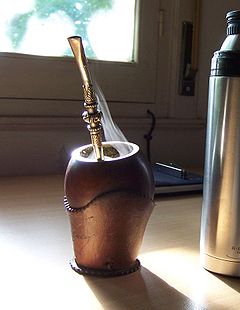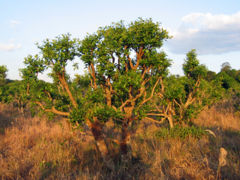介紹收集整理 瑪黛茶 Yerba Mate 的資料,
希望讓更多人瞭解這來自南美洲的健康飲品。
歡迎轉貼,請註明來源。
賣瑪黛茶啦 XD
賣瑪黛茶啦 XD @ PCHOME Store
賣瑪黛茶啦 XD @ Yahoo Mall
2008年11月25日 星期二
[轉貼] Tips To Drink Yerba Mate Like A Pro
美女表演如何喝瑪黛茶
Tips To Drink Yerba Mate Like A Pro from Gianny L on Vimeo.
[轉貼] 認識茶葉 - 何謂茶外茶?
萬年春茶業
何謂茶外茶?
| 茶外茶外茶意指雖稱為「茶」,卻以其他原料製成的飲料如麥茶、藥草茶等等,無論外觀 | ||
| 或味道都很特別,同時還擁有不可思議的功效。在此介紹三種比較特別的茶外茶。 | ||
| 一、 苦丁茶 | : | 據說具有提昇肝臟或胰臟的功能,不過味道很苦,有苦菜、墾丁、雲霧茶 |
| 等不同名稱,除了繩子狀之外,還有其他不同的形狀。 | ||
| 二、 雪 茶 | : | 採自喜馬拉雅山山丘地帶的植物,近來在日本也很常見,外觀像珊瑚一般 |
| ,有淡淡的芳香,據說對女性怕冷症非常有效。 | ||
三、 韓 國 | : | 韓國傳統茶已經達到無物不能入茶的程度。比較常見的是五穀茶,像大麥 |
傳 統 茶 | 茶、玉米茶等。藥草茶有五味子茶、百合茶…等。水果幾乎無一例外都可 | |
| 以製成水果茶,包括大棗茶、核桃茶、蓮藕茶…等,另外還有蔬菜茶、辣 | ||
| 椒茶、百年草茶。 | ||
[轉貼] 認識茶葉 - 茶的味道與香氣
萬年春茶業
茶的味道與香氣
| 茶的茶的味道主要取決於它本身所含的甘甜、澀味、苦味三種味道,通常好喝的茶基本上 | ||
| 都是味道取得一定的平衡,並非哪一味特別突出。此外,香味對中國茶的味道影響很大。 | ||
| 日本茶比較注重舌頭的感覺是甘醇或澀味,相較之下,中國茶則比較重視香味。話雖如此 | ||
| ,但味道和香味是互為一體的,例如鐵觀音,不光是舌頭有牛奶般的餘味,甚至連鼻子或 | ||
| 口腔也留有同樣的香味。 | ||
| 茶的茶的美味、甜醇,主要來自茶葉中所含的氨基酸類。綠茶約含有二十種氨基酸類中 | ||
| 所謂的單寧物,這也是它喝起來甘醇的原因。 茶之所以會有澀味,主要是因為含有兒茶素 | ||
| (茶單寧)的關係。發酵茶是讓一部分兒茶素轉變成多元酚類而產生風味。 日照過強的地區 | ||
| ,茶葉所含的兒茶素過多會太澀;而霧多的地區之所以能生產上等茶,因為霧可以遮蔽日 | ||
| 照,茶單寧不會受損。 | ||
| * 清 香 | : | 有清爽的花香味,原本是象徵台灣高山茶的特色,最近中國的烏龍茶也以稍 |
| 微發酵、最後加工輕微烘焙而成的清香茶的面貌上市。 | ||
| * 回 甘 | : | 喝過茶後留在口腔中的餘甘,好的茶越能持久回甘 |
| * 韻 | : | 主要是用來指烏龍茶的餘味,武夷岩石茶的強勁餘韻稱為「岩韻」,鐵觀音 |
| 的甘甜餘韻稱為「音韻」。 | ||
| * 黃枝香 | : | 採自廣東省潮州鳳凰山的茶葉所製成的烏龍茶,有鳳凰單欉黃枝香的香味, |
| 、 杏仁香 | 被比喻成玫瑰香,鳳凰單欉也有一種稱為杏仁香的樹,有杏仁的風味。 | |
| * 內酯類:上等烏龍茶會散發一股花香或果香等香甜味,很難想像是茶葉的香味,散發 | ||
| 這種香味的主要化合物是內酯類的成分,不妨把它想成像是茉莉花內酯類、 | ||
| 木夫寥內酯類的作用。 | ||
2008年11月17日 星期一
[轉貼] 認識茶葉 - 茶葉分類-依發酵程度
Source: http://www.evertea.com.tw/information/arcical/inf02.html
萬年春茶業
02 茶葉分類-依發酵程度
| 一、 不發酵茶 | : | 所有綠茶類屬之 |
*詳細 | : | 茶本身的酵素會發生作用,為防止這種現象,必須靠「加熱」的方法, |
| 而茶葉中所蘊含的大量兒茶素及綠色葉綠素也得以被保存下來,因此能 | ||
| 保有漂亮的綠色,按殺菁方法分類: | ||
| (1)炒青綠茶:用鍋炒方式乾燥製成的綠茶。如:龍井、碧螺春、信陽毛尖。 | ||
| (2)蒸青綠茶:鮮葉經高溫蒸氣殺青、揉捻、乾燥製成綠茶。茶條緊直略扁,如日本煎茶。 | ||
| 二、 全發酵茶 | : | 紅茶 |
*詳細 | : | 是指茶葉本身所含的酵素,讓它自然產生氧化的茶,將茶葉曝晒在陽光 |
| 下,再以搖晃等方式促進氧化,在此過程中會產生類似花香或果香,及 | ||
| 兒茶素減少所產生的獨特甘醇。紅茶是完全發酵,烏龍茶、包種茶則是 | ||
| 半發酵。 | ||
| 三、 半發酵茶 | : | 文山包種茶、凍頂烏龍茶、鐵觀音茶、東方美人茶(又稱白毫烏龍) |
*詳細 | : | 指發酵程度8~60%(又分輕發酵與重發酵),半發酵茶的製造,為中國製茶 |
| 的特色,全世界的茶葉製造,沒有能較其做法之繁複,變化之複雜,手 | ||
| 段之細膩,也當然無一能及其品質之優越者。套句俗話說正是『緊此一 | ||
| 家,別無分號』。 | ||
| 四、 後發酵茶 | : | 普洱茶 |
*詳細 | : | 意指讓加工完成的綠茶等產生微生物發酵作用的茶,製法是把茶葉放置 |
| 在潮溼的場所讓它發酵。 | ||
| 五、 著 香 茶 | : | 別稱加味茶,如茉利香片、伯爵茶 |
*詳細 | : | 讓紅茶、綠茶、讓茶附著花香或是風味的茶,但如今市面上的著香茶大 |
| 多是添加人工香料,而非使用真正的花香。 | ||
2008年11月10日 星期一
[轉貼] 認識茶葉 - 茶葉分類-依顏色可分為六大基本茶類
萬年春茶業
01 茶葉分類-依顏色可分為六大基本茶類
一、綠 茶:不發酵茶,有春草、豆子、栗子的香味
*描述:綠茶是以抑制茶葉本身的氧化酵素作製成的不發酵茶,由於多半是用鍋炒,因此所沖泡出的茶水色澤為淡黃色。沒有澀味,有類似豆子或是栗子的淡淡香味。
*製法:殺青(以鍋炒的方式防止茶葉的氧化酵素作用)→揉捻(用手將茶葉揉成形狀)→ 乾燥
*例如:龍井、碧螺春、黃山毛峰玉露、煎茶等
二、白 茶:輕發酵茶(發酵度為20~30%),有梅花、淡淡的果香
*描述:因為茶葉覆蓋著茸毛,看起來白白的所以稱為白茶。無論是產量或種類都很少,產地幾乎只限於福建省。製法是讓茶葉自然枯萎,讓它輕微的發酵,因此沖泡出來的茶色為黃色,而且還帶有甘甜的果香。
*製法:室內萎凋(將茶葉攤開在竹篩上讓它陰乾)→乾燥(加熱烘乾)
*例如:銀針、白牡丹
三、青 茶:半發酵茶(發酵度為30~60%),有花香、果香、蜂蜜、牛奶等甘甜的香味,既有綠茶的鮮濃,又有紅茶的甜醇。其葉片中間為綠色,葉緣呈紅色,故有「綠葉紅鑲邊」之稱。
*描述: 指的就是烏龍茶。產地為福建省、廣東省、台灣。以促進茶葉本身所擁有的氧化酵素作用所製成的酵茶。所謂青茶是將摘下的茶葉曝晒在陽光下,在促進發酵時,葉子會變成青色,而有此稱呼。
*製法:萎凋(日光萎凋/室內萎凋)→搖青(搖晃茶葉,讓它充分接觸空氣,促進發酵)→殺青→揉捻(以搓揉的方式增加茶葉的風味,揉成圓形等)→烘焙(乾燥)
*例如:鐵觀音、凍頂烏龍、包種茶
四、紅 茶:完全發酵茶(發酵度為80~90%),有蜂蜜或水果等甘甜的香味
*描述:相對於烏龍茶是半發酵的茶,紅茶則是百分之百完全發酵的茶。中國紅茶沒有澀味,主要特徵是有類似蜂蜜般的香味,不過,只有以雲南大葉種所製成的紅茶,感覺稍微有點澀味。
*製法:萎凋(以室內乾燥、晒太陽的方式去除水分)→揉/捻揉切(用力揉、切碎茶葉,破壞組織細胞,讓它充分發酵)→轉紅(發酵)→乾燥
*例如:祁門紅茶、荔枝紅茶
五、黑 茶:後發酵茶(發酵度為100%),有蓮葉、樹木的味道
*描述: 將加工完成的綠茶放置在潮溼的場所,以微生物發酵的方式製成的茶。散發成熟的果香,由於茶液的色澤極濃,因此稱為黑茶。產地為雲南省、廣西僮族自治區。
*製法:殺青(加熱防止茶葉氧化)→揉捻→渥堆(堆積茶葉,促進微生素發酵作用)→揉捻→乾燥
*例如:普洱茶、六堡茶等
六、黃 茶:輕後發酵(發酵度為10~20%),有強烈的果香
*描述:是極為稀少的茶,產地只限於四川和湖南省的少數地區。製法和綠茶很像,在烘乾茶葉的過程中,將它放置在潮溼處一~三天,讓它產生輕微的微生物發酵作用,因此茶葉的顏色會變黃。
*製法:殺青、揉捻、乾燥(過程幾乎和綠茶一樣)→悶黃(趁著茶葉仍有餘熱和水分時,將它塞進盒子,讓它輕微發酵)→乾燥
*例如:溫州黃湯、廣東大葉青、北毛尖等
2008年11月5日 星期三
禮盒包裝明年起將瘦身─環保署自95年7月1日起限制過度包裝
行政院環境保護署廢管處
禮盒包裝明年起將瘦身─環保署自95年7月1日起限制過度包裝
提供單位:行政院環境保護署廢管處
禮盒的過度包裝明年起將逐漸改善!為了節約資源,促進包裝材的回收,環保署自93年7月1日起,歷經25場公聽會、座談會、研商會及WTO預告,即將公告 「限制產品過度包裝」,第一階段自95年7月1日實施,管制糕餅、化粧品、酒類的禮盒及電腦程式著作光碟的包裝,第二階段自96年7月1日實施,納入加工 食品類的禮盒,產品超過規定之包裝層數或包裝體積比值的業者,將受到3萬元以上,15萬元以下的罰鍰,並限期改善。環保署籲請業者儘早在法令實施前,改變 產品的包裝設計,以符合大眾對合理包裝的期待,並降低廢包裝材對環境的衝擊。
「限制產品過度包裝」公告內容主要是限制各類禮盒的包裝體積 及包裝層數,各類禮盒的包裝體積應較額定包裝體積為小(包裝體積比值為1以下),而為鼓勵單一材質包裝,以利回收再利用,單一材質禮盒的額定包裝體積,則 較非單一材質者稍大;額定包裝體積為禮盒內產品體積的2.7倍(禮盒非單一材質)或3.1倍(禮盒為單一材質),糕餅禮盒的額定包裝體積,則為裸餅體積的 6.0倍(禮盒非單一材質)或6.9倍(禮盒為單一材質)。包裝層數部分,化粧品、酒及加工食品之禮盒的包裝層數應在2層以下,糕餅禮盒及電腦程式著作光 碟產品之包裝層數應在3層以下(如附表)。
環保署表示,去年檢驗之70件中秋禮盒中,有近六成包裝不符合「限制產品過度包裝」公告的規 定。而今年中秋節前,環保署也將採樣檢驗中秋禮盒包裝,以輔導業者及早因應,避免過度包裝。明年公告實施後,環保署預期禮盒過度包裝之情形將大幅減少,民 眾將可過個有環保味的中秋節。
配合「限制產品過度包裝」之實施,環保署將委託民間機構辦理包裝檢驗,預計今年8月起,業者就可將產品送 驗,以確認是否符合法令,業者亦可將經檢驗的包裝層數、包裝體積比值及包裝材質等資料標示在產品上,方便消費者選擇適度包裝的產品,包裝層數及包裝體積比 值愈小,表示愈節省包裝,包裝材質種類愈少,愈有利包裝的回收再生。
環保署指出,「限制產品過度包裝」實施後,將導引消費品之包裝走向省 資源、易回收之設計,並降低包裝材料的使用量及廢棄量。環保署估計,列管產品每年的包裝使用量為26,600噸,第一階段實施後,每年將減少使用 3,700公噸的包裝材料,第二階段實施後,每年將再減少使用3,200公噸的包裝材料,合計每年可減少使用6,900公噸包裝材料,減量比率為26%。
2008年11月2日 星期日
[論文] Yerba Mate Tea (Ilex paraguariensis): A Comprehensive Review on Chemistry, Health Implications, and Technological Considerations
ABSTRACT
ABSTRACT: Yerba Mate tea, an infusion made from the leaves of the tree Ilex paraguariensis, is a widely consumed nonalcoholic beverage in South America which is gaining rapid introduction into the world market, either as tea itself or as ingredient in formulated foods or dietary supplements. The indigenous people have used it for centuries as a social and medicinal beverage. Yerba Mate has been shown to be hypocholesterolemic, hepatoprotective, central nervous system stimulant, diuretic, and to benefit the cardiovascular system. It has also been suggested for obesity management. Yerba Mate protects DNA from oxidation and in vitro low-density lipoprotein lipoperoxidation and has a high antioxidant capacity. It has also been reported that Yerba Mate tea is associated to both the prevention and the cause of some types of cancers. Yerba Mate has gained public attention outside of South America, namely the United States and Europe, and research on this tea has been expanding. This review presents the usage, chemistry, biological activities, health effects, and some technological considerations for processing of Yerba Mate tea. Furthermore, it assesses in a concise and comprehensive way the potential of Ilex paraguariensis as a source of biological compounds for the nutraceutical industry.
[轉貼] 瑪黛茶主要特性
# Energize The Body
補給身體能量
# Stimulate Mental Alertness
提神醒腦
# Aid Weight Loss
幫助減重
# Cleanse The Colon
促進體內環保
# Gentle Diuretic
溫和的排水利尿
# Accelerate Healing Process
促進身體新陳代謝以及自癒能力
# Relieve Stress
減輕精神壓力
# Calm Allergies
減緩過敏症狀
# Fortify Immune System
增強免疫系統能力
# Increase Longevity
減少自由基 延年益壽
2008年10月30日 星期四
[轉貼] 美國官方有機標章USDA
台灣環境保護聯盟
當美國尚未制訂統一的有機品認證標準前,全國有33個私人和11個州立的有機農產品認證機構,各有不同的認證標準及標章,經常讓眾多消費者感到非常困惑。
美國農業部以1990年通過的「有機食品生產法」制訂了「國家有機計畫」(National Organic Program,簡稱NOP),開始實施全國性的有機品認證標準,確保市面上強調「有機」的農產品皆合乎一致且統一的標準,以利有機產品的交易,也確保消 費者的購買權益。自2002年10月起,使用國家有機標章及文字標示,皆須合乎美國有機農業計畫 (National Organic Program,簡稱NOP)所訂定的產品規範,才能標示有機字樣或張貼有機標章,認證標示也會因產品的有機原料所佔的比例不同而有不同的標準。NOP的 認證,由美國農業部(United States Department of Agriculture,簡稱USDA)授權的標章──美國官方有機標章(USDA)所授權,其認證標準的規定,有機生產和處理業者須完全遵守,供應商也 須經由NOP認證,才能獲得認證機構的授權。僅有以下幾例例外:
‧出售有機產品年營業額少於5000美元的小農戶,可直接將產品賣給消費者。
‧雜貨店及餐廳等零售商。
‧僅以經營有機食品包裝的公司。
國外農產品的認證方式
國外進口的農產品,若通過USDA的認證,其產品才能在美國銷售。目前USDA已授權給數個海外國家認證機構,尚有多國認證機構正在申請授權。
除了獲得USDA的授權外,其他外國政府若提出要求,而USDA也認定該國政府具有符合USDA規定的海外認證機構,亦可獲得USDA的認可。若有 機產品相關業者在知情的情況下,仍將不符合USDA之規定的產品以有機為名進行銷售或標示,最重將獲政府單位處10,000美元的民事罰款。
2008年10月29日 星期三
[轉貼] 世界三大名茶 瑪黛茶具保健作用
大紀元時報
世界三大名茶 瑪黛茶具保健作用
瞄 準現代人愛美更愛瘦的心態,越來越多保健食品陸續上市。從甲殼素、籐黃果、綠茶、優酪乳、酵素到辣椒素,許多減肥的人都樂於嚐試。其中,綠瑪黛是用瑪黛樹 的葉片,經過特殊處理後萃取製成。瑪黛樹原產於南美洲,生長在海拔5000公尺以上的安地斯高原,萃取物當中,含有天然多酚和皂素等稀有元素。
所謂的多酚就是植物的內分泌及防禦系統,自古就被認為具有天然療效。瑪黛茶被稱做世界三大名茶之一,一方面控制飲食,一方面提供養份,在巴西等中南美洲國家,是很一般的飲料。
現在生技業者利用瑞士方面的專利技術,將綠瑪黛葉的萃取物加進義式即溶咖啡,以法式調法,讓咖啡和植物性奶精、牛乳蛋白、果糖及萄萄糖互相調合,發展出具有咖啡香味的飲品。至於這個來自南美洲的飲料,有了新風貌之後,是否可以得到台灣消費者的青睞,還有待後續觀察。
2008年10月28日 星期二
[轉貼] The Argentine Mate Language
The Argentine Mate Language

The word maté derives from the quichua word "mati", which means glass or recipient for drinking, but it has been generalized as the common name of the fruit of the gourd plant–
Lagenaria vulgaris- especially the varieties used to prepare and serve the infusion of yerba maté ("poro" and "galleta").
So, with the later proliferation of gourds made of the most varied materials, destined to prepare this infusion the word maté began to be used to refer also to any kind of container. Then, the word "maté" began to name the infusion itself.
According to the way this beverage is prepared, it is known as:
"Amargo" (bitter), "verde" (green) or "cimarrón": it is the maté without sugar
"Dulce" (Sweet): prepared with sugar
"Tereré": bitter maté brewed with cold water
"Cocido" (cooked) or "Yerbeao": prepared like tea.
In this section we will refer mainly to the brewed maté (sweet or bitter), inseparable companion of our people.
Colloquially people also use the word maté to refer to the head
According to the way or the ingredients used to brew the maté, it is, for the popular tradition, a comunicator of moods or brewer’s desires towards the one who will drink the maté.
Unsweetened maté: Indifference
Sweet maté: Friendship
Very sweet maté: Talk to my parents
Cold maté: Despise, indiference
Maté with balm: Disgust
Maté with cinamon: You are in my thoughts
Maté with burnt sugar: I like you
Maté with orange peel: Come for me
Maté with tea: Indifference
Maté with coffee: Forgiven offense
Maté with molasses: I sympathize with your sadness
Maté with milk: Esteem
Very hot maté: I’m so in love with you
Boiling maté: Hate
Tasteless maté: Repulse
Maté with cedrón: Agreement
Maté with honey: Marriage
Obstructed maté: Repulse
Foaming maté: True love
Consecutive matés: Ill will
Maté with Ombú: It is equivalent to streghten the maté
Maté brewed through the bombilla: Dislike
[轉貼] How to Cure the Gourd / Mate
How to Cure the Gourd / Mate
CURING THE MATE GENERAL INFORMATION

It is called "curar el mate" (cure the maté) to the process of adapting this container to the infusion that it will be destined to hold.
Only those made of porous materials admit this process (especially and par excellence those made with a hollowed out calabash), since their inner walls will be able to be impregnated with the "spirit of the yerba" making the infusion to mature with an intimate antique touch, as appreciated by the experimented "matero" as the quality of the yerba itself.
GENERAL INFORMATION

There are two steps in the process of curing the maté: the curing itself and the usage which improves the curing as time goes by.
The act of curing the maté has two purposes:
A) Removal of interior skin:
B) Process of adaptation:
1) REMOVAL OF INTERIOR SKIN:
It consists of eliminating the soft skin of the inner walls of the calabash. (In the case of the matés made of wood or any other porous material, this process is nor necessary)
The New calabash is filled with a used and wet brewing, taken from a maté in use, preferable bitter. Then, a squirt of hot water is poured and it is left resting during one day. When that time is over the yerba is removed and the calabash is well rinsed. Then the inner walls are scraped with an appropriate object to take off the soft skin, almost loose by the maceration effect. Once this process has been finished, it is rinsed again with plenty of water and the operation is repeated from the begining.
2) PROCESS OF ADAPATION OR "CURADO":
It is previous to the type of infusion that it will be destined to hold
DO THE FOLLOWING STEPS
a) Galleta (bitter maté): fill it up with a new brewing, then add boiling water and let it rest until the following day.( 24hrs.)
Empty the maté and rinse it with water.
NOTE
The strong infusion provoked by the boiling water will impregnate the walls of the "galleta", which will be ready to be used.
There are people who repeat this operation for two or three days, and sometimes is better this way. It allows a better impregnation of the inner walls
INSTRUCTION FOR THOSE WHO WILL DRINK SWEET MATE
b) Poro (sweet maté): Put two or three teaspoons of sugar and quickly add a well lit ember. Cover the mouth of the maté and shake it energetically so that the sugar is burnt.
The sugar and the smoke of its combustion sweeten and scent the bark of the "poro".
CURING THE MATE STEP BY STEP
STEP # 1

Fill the calabash with a used and wet brew, taken from a maté in use,if you have one, preferably bitter
STEP # 2

Pour a squirt of hot water and it is left resting during one day.
STEP # 3

Remove the yerba.
STEP # 4

Rinse the calabash
STEP # 5

Scrape the inner walls with an appropriate object to take off the soft skin, almost loose by the maceration effect.
STEP # 6

Fill it with a new brew, then add boiling water and leave it to rest till the following day. Rinse again with plenty of water and the operation is repeated from the beginning.
Now you are ready to Go!
Drink Mate four five times a day, for breakfast, midmorning, after lunch, after supper and late in the evening.
If going out on a trip, Get yourself a ThermoBottle with hot water and carry the mate with you. If Driving, train your copilot to serve or "cebar" mate while you enjoy the driving
In Argentina most of us carry a MATE EQUIPMENT in our car when traveling that consist of:
A stove furnace like a " Coleman" or similar
A Stainless Steel or Aluminum Kettle
A Thermo Bottle
A package of Yerba Mate of your preference.
A gourd or two.( just in case )
A bombilla or two.( Just in case )
A Bottle with plenty of Fresh Water to heat.
A pot of sugar ( if you like sweet mate - I don't - Bitter is Healthier!)
Matches
America has wonderfull and beautiful REST AREAS build on its Highways all accross the Nation.
To stop on a Large Trip , heat some water, and either drink some mates there or keep going will shorten the trip like you can not imagine!
Now after this humble advise, enjoy and be healthy and happy!
[轉貼] The Yerba Mate Legend

The word legend is used to mean a traditional narration that it is generally told as if it had been a true event and not a fiction story. They are stories of phenomena or historical events that were famous because of their real or imaginary characters, because they were anonymous, traditional and popular. They tell events that they are supposed to have happened some time in a very remote time and that solve the origin or reason of elements, customs or beliefs of a certain culture
The Yerba Mate Legend
There is an old Guarani Indian legend that relates the origins of the Guarani in the Forests of today Northeast Argentina. According to the legend, the ancestors of the Guarani at one time in the distant past crossed a great and spacious ocean from a far land to settle in the Americas. They found the land both wonderful yet full of dangers; through diligence and effort they subdued the land and inaugurated a new civilization.
The Guarani tribes worked the land and became excellent craftsmen. They looked forward to the coming of a tall, fair-skinned, blue eyed, bearded God (Pa' i Shume) who, according to legend, descended from the skies and expressed his pleasure with the Guarani. He brought religious knowledge and imparted to them certain agricultural practices to be of benefit during times of drought and pestilence as well as on a day-to-day basis.
Significantly, He unlocked the secrets of health and medicine and revealed the healing qualities of native plants. One of the most important of these secrets was how to harvest and prepare the leaves of the Yerba Mate tree. The Mate beverage was meant to ensure health, vitality and longevity.
It was like this: the tribe would clear part of the forest, plant manioc and corn, but after four or five years the soil would be worn out and the tribe had to move on. Tired of such moving, an old Indian refused to go on and preferred to stay where he was. The youngest of his daughters, beautiful Jary, had her heart split: to go on with the tribe's youths, or remain isolated, helping the old man until death would take him to Ivy-Marae's peace. Despite her friends' pleas, she ended up staying with her father.
This love gesture deserved a prize. One day, a unknown shaman arrived at the ranch and asked Jary what she wanted in order to feel happy. The girl did not ask anything. But the old man asked: "I want new forces to go on and take Jary to the tribe that went away". The shaman gave him a very green plant, perfumed with kindness, and told him to plant it, pick the leaves, dry them on fire, grind them, put the pieces in a gourd, add cold or hot water and sip the infusion. "In this new beverage, you will find an healthy company, even in the sad hours of the cruelest solitude." After which he went away. Thus was born and grew the "caá-mini," whence came the caá-y beverage that white people would later adopt under the name of Chimarrão in Brazil and Yerba Mate or Cimarron in Argentina, Uruguay and Paraguay.
Sipping the green sap, the old man recovered, gained new strengths and was able to resume their long journey toward meeting their kinsmen. They were received with the greatest joy.
And the whole tribe adopted the habit of drinking the green herb, bitter and sweet, that gave strength and courage and would comfort friendships at the sad hours of utmost solitude. Mate became the most common ingredient in household cures of the Guarani, and remains so to this day. In current practice in modern Argentina and Paraguay, Mate tea is made from the leaves steeped in hot water. Actually, a large quantity of ground leaf is first soaked in cold water, then the hot water is added, over and over again, until all the good stuff has been extracted. In between each addition of hot water the tea is ingested through a special wood or metal straw, called a bombilla, that filters out the leafy material. It is also used as a cold beverage.
[轉貼] Yerba Mate - When?
Leaves of yerba mate were used by the Guaraní people before the Conquista. The oldest written document mentioning it is a Spanish chronicle of 1537. It describes a beverage prepared by the natives of Guayrá region, drunk in a small gourd through a pipe made of tacuapí cane and wrapped in a fabric. The Spanish called the beverage yerba mate. In Spanish yerba or hierba means just a herb or a grass. It is the equivalent of Guaraní word ka'a. The word mate most probably derives from the Quechua language, in which matí means a gourd.
At the beginning the Spanish were reluctant to the unknown stimulant. In 1596 the governor of Asunción Arias de Saavedra issued a decree, which forbade drinking of mate. However gradually – also because of the support of Jesuits, who considered mate a good alternative to alcohol, mainly chicha and guarapo – yerba mate was gaining importance. It were Jesuits, who mastered the technique of yerba mate cultivation (ca 1670) and established first plantations by villages and reductions. Yerba, which was produced by them, was used not only in the area of present Argentina, Paraguay and Uruguay but also exported to the viceroyalty of Peru and the captaincy general of Chile. The Jesuits quickly understood that firstly, due to yerba Guaraní workers worked longer and more effectively, and secondly, the cultivation of yerba mate may be a good source of revenues. The Jesuits almost exclusively controlled the production until the dissolution of the order in 1767.
In the next years the production on plantations was decreasing and most yerba was harvested from wild growing trees. As a result of the liberation wars the area of yerba mate occurrence was parted between the newly established states. At first most of the production came from Paraguay. At the same time the harvests in Brazil were increasing and Argentina – the biggest consumer – introduced a number of decrees regulating the production of yerba and encouraging farmers to establish plantations. Also scientific research was undertaken to work out methods of growing trees from seeds (Jesuits strongly guarded this secret and took it away).
In the middle of the 20th century in Misiones province in Argentina there were some 40 thousand colonists. Around 25% of them grew yerba mate. In this group there were many Poles, who came to Argentina with a first big “bread” emigration and together with the colonists from Ukraine were settled in Misiones province, mainly in two centers: Apóstoles (established in 1897) and Azara (1901). They played very active role in the development of the yerba mate plantations. Nowadays many leading companies and plantations still belong to their descendants. One of them was Julian Szychowski, establisher of the La Cachuera farm, which produce very popular brand Amanda. His son Jan also significantly contributed to the development of the yerba mate industry and in 1985 he was awarded posthumous Yerba Mate medal by the Ministry of Agriculture. The company is currently one of four biggest yerba mate producers in Argentina.
[轉貼] Yerba Mate - How?
How to choose a mate?
I suggest buying a traditional mate made of gourd. It mellows with age and absorbs the taste of yerba. The only advantage of a metal mate is that it is easier to pack while traveling. I personally prefer the gourd.
A new gourd must be properly prepared. First, you put yerba inside, then you pour hot water into the mate and leave it for one day. Next day you throw out all the contents, wash the mate and scrape the remains of the fibers of the gourd walls. You may repeat the whole process once again: put yerba inside the mate, pour boiling water and leave it for another day.
When you become addicted to this energizing beverage, you should think about buying a thermos. In South America there are special thermoses for drinking mate. They are equipped with a pipe that facilitates pouring water into the mate. Nevertheless an ordinary thermos is good as well. A thermos is especially handy while being outside, and people carrying thermoses on the streets are nothing strange in Buenos Aires or Montevideo.
How to prepare a mate?
Warm up water. It is important to remember not to boil it. The temperature of water for mate should be around 70°C. Lazy sipping of mate is so natural in the north of Argentina, that in the streets you may find machines with free hot water. An important element of such machine is a thermometer showing the temperature of water. Too hot water burns the leaves and makes mate watery and tasteless. According to some sources it is not only due to excesive temperature but also to the amount of oxygen dissolved in water, which is much lower in higher temperature.
Fill 3/4 of the mate with yerba. Tap the opening with your hand and turn the mate upside down, shaking lightly. Turn it back to its normal position, inclining slightly so that most of the leaves gather on one side of the gourd. Thrust bombilla into the side where there is less yerba. From that moment on don't move the bombilla. Next pour hot water inside. Do it slowly. You may pour it over the bombilla. Water should cover all the leaves. Wait a moment until the infusion get stronger. At last, drink!
Some people prefer to drink sweet mate. In such case you put some sugar into the mate before each pouring of water into it. You must however remember that a gourd used for drinking bitter mate should never be used for drinking a sweet one.
Yerba mate may also be drunk with cold water with addition of ice and some refreshing herbs. Such beverage is called tereré and is popular in Paraguay.
How to drink?
Drinking mate is not only a way to quench. It is a ceremony. A comparison to smoking a peace pipe will not be exaggerated. You often drink mate with a bunch of friends and invitation to the ceremony may be a form of social acceptance.
A host usually plays the role of a master of ceremony. It is him who prepares mate, pours water in and customary drinks first. He drinks until the mate is empty and the air starts to enter the bombilla. Nota bene the sound of slurping is very acceptable here. Next he pours new water in and gives the mate to first of his guests. According to the rules of Southamerican savoir-vivre, the bombilla should always point at the person to which mate is offered. The guest drinks until he empties the mate, which is signaled by slurping, and gives the vessel back to the host without saying “thank you”. If you thank your host he understands that you don't want more and will pass you over during the next round. All the guests get their mate, one after another. Then it is host's turn again, and then the second round starts in the same order.
When the mate starts loosing its taste, the host throws out all the contents (using bombilla) and fills it anew. The ceremony lasts as long as the last of the guests wants to drink. However drinking mate is not the focal point of the meeting. It is only a pleasant addition accompanying the meeting.
From time to time the bombilla gets clogged. Then some people rub the bottom of the mate with palm of their hand and the bombilla gets unblocked. I don't know how to explain this phenomenon, but it works.
Generally there is some magic involved in mate. The Argentineans say that you need a good hand for mate. And in fact there are some people, who will never prepare good mate!
[轉貼] Yerba Mate - Where?
The natural habitat of yerba mate, as well as the area under cultivation is, roughly, limited to the west by the Paraguay river, to the east by the Atlantic Ocean, to the north by the 18th parallel of south latitude and to the south by 30th parallel of south latitude. Efforts to cultivate yerba mate in regions of similar climate in North America, Asia or Africa have not succeeded yet.
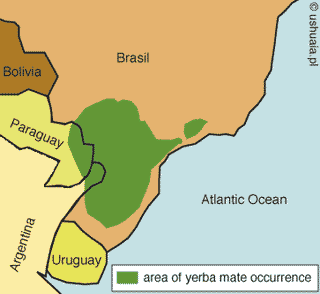
The plant needs at least 1500 mm of rainfall per year, an average monthly temperature between 15,5 and 28°C. It is able to survive short‑term temperature falls to -8°C.
It grows mainly on sandy-clayey and clayey-sandy soils, rich in phosphorus, potassium, iron, developed on permeable subsoil.
Almost 80% of the area of occurrence is located on the territory of Brazil, mainly in the following states: Paraná, Santa Catarina, Rio Grande do Sul, and also: São Paulo, Mato Grosso do Sul and Minas Gerais. Most of yerba mate leaves used for production in this country is harvested from wild growing trees. However in recent years the area under cultivation has been growing. In Argentina top ranks in terms of the quantity of production belong to two provinces: Misiones (more then 85% of the country total production) and Corrientes. Those provinces are also main area of yerba mate processing industry. Yet a few big companies are located in Buenos Aires.
The biggest producers — Argentina, Brazil and Paraguay are at the same time the biggest consumers. In Brazil most consumers live in the area of production, while in Argentina and Paraguay it is consumed all over the country. Other yerba mate consuming countries in South America are Uruguay, Chile and Bolivia. Another important region of yerba mate drinking in the world is Middle East, mainly Syria and Lebanon. The habit of drinking yerba mate came to this region with emigrants returning from South America. Syria is world's biggest importer of yerba mate.
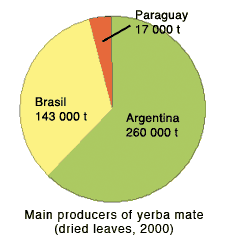
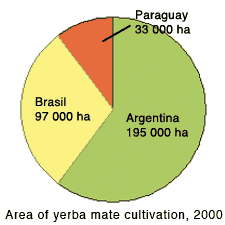
[轉貼] Yerba Mate - What?
Ushuaia.pl
Yerba mate [ˈɟɛrβa ˈmate] is drunk mainly in Argentina, Brazil, Paraguay and Uruguay. It is an equivalent of our tea or coffee, which traditionally accompanies our social gatherings. The taste of mate, however, is by no means similar to black tea or coffee. It could be compared to the taste of green tea but true mate lovers would of course deny it. Both mate and green tea are bitter but the bitterness is of different kind. In above mentioned countries yerba mate is consumed almost habitually, which is reflected by numbers: the average Argentine buys nearly 7 kilograms of mate yearly.
And now some basic information.
“By the name yerba or yerba mate one understands a product consisting of dried, slightly toasted, ground leaves of Ilex paraguariensis Saint Hilaire, alternatively with an addition of fragments of dried young sprigs, sprouts or flower stems. (...)”
(Argentine Alimentary Code; No. 18.284, Chapter 15, Article 1193)
Yerba mate, Ilex paraguariensis, is a specie of holly (family Aquifoliaceae). In its natural habitat, during 25 years it may grow up to 15 m, while cultivated — up to 3–6 m. It blossoms from October till December. Its leaves are elongated, evergreen and glossy, up to 5 cm long, with a serrated margin; small, yellowish, 4-petal flowers are gathered in bunches sprouting from the edges of leaves; fruit — violet-red drupe with several seeds. The natural habitat, as well as the area of cultivation, is limited to the South America, more precisely to the zone between the Atlantic Ocean and Paraguay river, and between 18°S and 30°S. Leaves contain caffeine and theobromine — alkaloids that stimulate central nervous system. Some researches [Kamangar et al.] show high concentration in leaves and infusions of polycyclic aromatic hydrocarbons (including benzo-α-piren), which are human carcinogens.
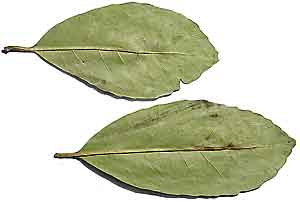
Composition of yerba mate infusion. Average values in the infusion prepared of 100 g of dry product. | |||
| Ingredients | 'tea-bag' infusion | warm mate | cold mate |
| Glucose (g) Sucrose (g) Proteine (g) Caffeine 1 (g) | 0,54 2,97 3,69 1,27 | 0,59 2,77 2,14 0,85 | 0,15 1,19 1,24 0,44 |
| Vitamins Vitamin C (mg) Thiamine B1 (mg) Niacin (mg) Pyridoxine B6 (mg) | 4,89 1,59 4,38 0,54 | 5,11 1,48 1,27 0,94 | 2,35 0,15 — — |
| Minerals Calcium (mg) Phosphorus (mg) Iron (mg) Magnesium (mg) Potassium (mg) Sodium (mg) | 107,25 60,5 2,54 86,96 99,64 27,54 | 80,94 45,89 2,22 58,58 100,59 14,04 | 43,90 21,27 1,10 33,17 41,63 11,07 |
| 1 Caffeine in yerba mate is sometimes reffered to as mateine. At the same time there are no proofs that this alkaloid differs from caffeine. It is rather a marketing trick. | |||
Dictionary
p — Portuguese, g — Guaraní, other words are of Spanish origin
azucarera — sugar bowl
bomba — (p) » bombilla
bombilla — a small pipe through which you drink mate, tipped with a filter, usually made of metal (stainless steel, silver); can be straight or curved; filter is often disassemblable; there is a thickening by the mouthpiece, which absorbs heat
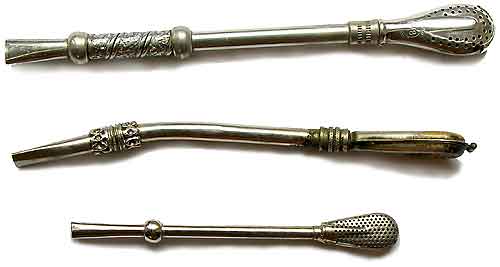
canchado — one of the stages in the production process, when the leaves are coarsely ground
cebador — a person that serves mate, a master of ceremony
chá-mate — (p) » mate cocido
chimarrao — (p) » yerba mate (1)
erva mate — (p) » yerba mate
galleta — mate (2) of round flattened shape
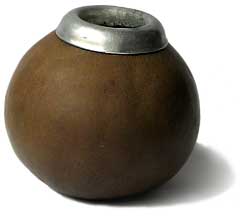
guampa — [Quechua huampa — horn] mate (2) made of cattle horn
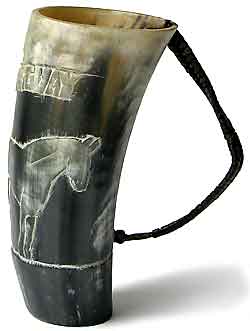
ka'a — (g) » yerba mate (3)
ka'ay — (g) » mate (1)
ka'ygua — (g) » mate (2)
mate — [Quechua mati — gourd] 1. a beverage made by pouring hot (not boiling) water over yerba mate; 2. a vessel for drinking mate, usually made of gourd (Lagenaria vulgaris); also of wood - eg. hard guayacan (palo santo), cattle horn, metal
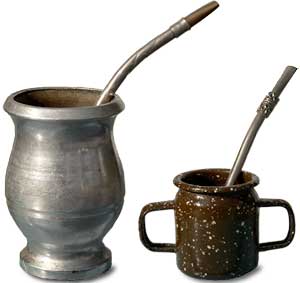
~ amargo, ~ cimarrón, ~ verde — mate without sugar
~ cocido, ~ yerbeado — mate drunk like tea, in a cup, poured with boiling water
~ de leche — mate with milk instead of water
~ dulce — mate with sugar
~ lavado — mate after many refills, without taste
cebar el ~ — to prepare mate, to pour water to mate
curar el ~ — to prepare a gourd for the first use
matero — 1. a person drinking mate; 2. (in Paraguay) mate (2)
pava — a kettle
poro, porongo — (in North-Eastern Argentina, Southern Brazil) mate (2) of elongated shape, pear-like
tereré — (g) (especially in Paraguay) yerba mate poured with cold water, often drunk with ice, herbs, juice; the name derives from the sound of slurping
yerba mate — 1. dried, ground leaves of yerba mate prepared for making infusions; 2. fresh leaves of yerba mate; 3. yerba mate tree (Ilex paraguariensis)
~ canchada — semi-finished product in the yerba mate production process; dried, coarsly ground leaves of yerba mate
~ compuesta — yerba mate with addition of herbs, eg. mint
~ elaborada, ~ elaborada con palo — yerba mate containing not less then 65% of dried leaves and not more then 35% of dried stems, sprigs, sprouts etc. Sometimes the quality of yerba mate is also described by symbol P.U. followed by numer from 1 to 3, where P.U.2 roughly refers to elaborada
~ elaborada despalada, ~ elaborada despalillada — yerba mate containing not less then 90% of dried leaves and not more then 10% of dried stems, sprigs, sprouts etc.; also marked as P.U.1
~ tostada — yerba mate subjected to the process of toasting
yerbera — a container for storing yerba mate (1)
zapecado — first stage of the processing of the leaves when they are briefly exposed to very high temperature (up to 460°C)
[轉貼] Yerba Mate: South America's Health Drink
Natural News
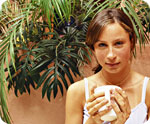 | Yerba Mate: South America's Health DrinkMonday, September 22, 2008 by: Tony Isaacs (see all articles by this author)Key concepts: Yerba mate, Health and Antioxidant |
(NaturalNews) More than a drink, Yerba Mate (pronounced "yerba mahtay") has become a cultural phenomenon throughout South America and its use is rapidly spreading to the United State. Its benefits are obvious. In Buenos Aires, where people carry their Mate with them throughout the day, the sight of an obese person is rare.
Known to South Americans as the "Drink of the Gods", yerba mate is a hot beverage made from the dried leaves of the Ilex Paraguariense bush indigenous to Argentina, Brazil, Paraguay and Uruguay. And thanks to its caffeine-like content, the drink is a natural stimulant.
Yerba Maté has been used since ancient times as a tea, is recommended throughout South America for its rejuvenating, nutritional, and energizing effects, particularly for mental and physical fatigue. Yerba Maté can be taken as an effective weight-loss aid and scientific research shows Maté to be a powerful antioxidant and that it can protect DNA from double-strand breaks. It also has the ability to inhibit LDL oxidation. Maté naturally contains a wide range of polyphenols, methylxanthines, and chlorogenic acid, which together are responsible for its many health benefits.*
Traditionally steeped and served in a hollowed-out gourd and sipped through a metal straw designed to filter out stems and leaf bits, yerba mate was first consumed by the Guarani Indians centuries ago.
It is the national drink of Argentina, where drinkers of yerba mate (pronounced yair-ba mah-tay) are even more ubiquitous than coffee drinkers in the United States. It is not uncommon to see Argentines walking down the street sipping out of a mate gourd.
In recent years, its popularity has spread to the United States, where countless online vendors and teahouses, coffee shops and restaurants from Boston to Los Angeles are catering to an adapting palate. Those who drink it say they have turned to the beverage as an alternative pick-me-up with less caffeine and acidity than coffee and a host of supposed health benefits.
Many Americans may not like Yerba Mate the way Argentinians drink it –- as it has an earthy and somewhat bitter taste. For that reason, many sellers in the U.S. are blending yerba mate with mint, vanilla, orange or other flavorings.
Web vendors claim the beverage, which contains a mix of vitamins and amino acids, can "boost immunity, restore youthful hair color, retard aging, combat fatigue, control the appetite and eliminate insomnia", and more –- and research is tending to support many of those claims, such as finding Yerba Mate to have hypocholesteremic (cholesterol lowering), antioxidant, hepato protective (protecting the liver) properties and a bitter taste -– all of which are attributed to the phenolic constituents of the leaves.
Yerba Mate is packed with naturally-occurring nutrients and anti-oxidants and there are 196 volatile (or active) chemical compounds found in the Yerba Mate plant. Of those, 144 are also found in green tea. Yerba Mate contains 11 polyphenols. Polyphenols are a group of phytochemicals. Phytochemicals (phyto- meaning plant) are recently-discovered compounds that act as powerful antioxidants and are considered to exhibit anti-cancer effects in mammals by strengthening an organism's natural defenses and protecting it against cellular destruction (i.e. lycopene in tomatoes, flavonoids in blueberries, and isoflavones in soy).
Yerba Mate has caffeoyl derivatives (caffeic acid, chlorogenic acid, 3,4-dicaffeoylquinic acid, 3,5-dicaffeoylquinic acid and 4,5-dicaffeoylquinic acid) and flavonoids (quercetin, rutin and kaempferol). In addition to polyphenols, Yerba Mate leaves contain saponins (In fact, one recent study yielded 3 new saponins in the Yerba Mate leaf!) Saponins are phytochemicals that have been found to specifically stimulate the immune system and aid the body in protecting against disease.
In 2005, researchers at the University of Illinois studied 25 different types of mate. They found the tea to contain "higher levels of antioxidants than green tea"... and, based on cell studies, "may help prevent oral cancer."
Each infusion of Mate contains:
* Vitamins - A, C, E, B1, B2, Niacin (B3), B5, B Complex
* Minerals - Calcium, Manganese, Iron, Selenium, Potassium, Magnesium, Phosphorus
* Additional Compounds - Fatty Acids, Chlorophyll, Flavonols, Polyphenols, Trace Minerals, Antioxidants, Pantothenic Acid and 15 Amino Acids.
According to Dr. Mowrey, Director of Mountainwest Institute of Herbal Sciences, one group of investigators from the Pasteur Institute and the Paris Scientific Society concluded that Yerba Mate contains "practically all of the vitamins necessary to sustain life". They focused especially on Pantothenic Acid, remarking that it is "rare to find a plant with so much of this significant and vital nutrient... It is indeed difficult to find a plant in any area of the world equal to Mate in nutritional value."
In addition, results from a study done by researchers at the University of Madrid assert a high content of mineral elements, especially K, Mg, and Mn, in Mate. They considered those findings "to be of great relevance" to the nutritional value of Mate infusions.
Yerba Mate Research:
Vascular responses to extractable fractions of Ilex paraguariensis -- yerba mate -- in rats fed standard and high-cholesterol diets.
Biol Res Nurs. 2005 Oct;7(2):146-56.
Programa de Pos-Graduacao em Ciencias Fisiologicas-Fisiologia Animal Comparada, Fundacao Universidade Federal do Rio Grande, Brazil.
The authors investigated the vasorelaxant properties of the aqueous and acid n-butanolic extractable fractions from yerba mate leaves. Perfusion pressure was evaluated using isolated and perfused mesenteric arterial beds (MABs) from rats fed hypercholesterolemic and standard diets. Extract-induced vasorelaxation in the presence and absence of various inhibitors was examined. These results suggest that yerba mate induces vasodilation in rats fed a standard diet in a dose-dependent manner and that the hypercholesterolemic diet substantially reduced the effect of yerba mate.
Naturally occurring proteasome inhibitors from mate tea (Ilex paraguayensis) serve as models for topical proteasome inhibitors. - J Invest Dermatol. 2005 Aug;125(2):207-12. Arbiser JL, Li XC,
Department of Dermatology, Emory University School of Medicine, Atlanta, Georgia 30322
Proteasome inhibitors have emerged as a clinically important therapy for neoplastic disease, with velcade, an organoboron compound used extensively in multiple myeloma. Recently, epigallocatechin gallate has been found to be a potent inhibitor of the proteasomal chymotrypsin-like activity. Other compounds that inhibit angiogenesis and are active as chemopreventive agents, such as curcumin, also inhibit proteasome activity. We have screened natural product extracts and found that extracts of yerba mate tea (Ilex paraguayensis) inhibit the growth of these endothelial cells. The extract was fractionated and found to have novel cinnamate esters that inhibit proteasome activity. Based upon these findings, preclinical and clinical trials of topical cinnamate esters as proteasome inhibitors are warranted for psoriasis and other inflammatory disorders.
Ilex paraguariensis -- Yerba Mate -- extracts inhibit AGE formation more efficiently than green tea. - Fitoterapia. 2005 Jul;76(5):419-27. Lunceford N, Gugliucci A.
Glycation, Oxidation and Disease Laboratory, Division of Basic Medical Sciences, Touro University-California, Mare Island, Vallejo, CA
Glycation, the nonenzymatic adduct formation between sugar dicarbonyls and proteins, is one key molecular basis of diabetic complications due to hyperglycemia. Given the link between glycation and oxidation, we hypothesized that herbal extracts with a high concentration of antioxidant phenolics might possess significant in vitro antiglycation activities as well. The aim of the present study was to address the hypothesis that polyphenol-rich yerba mate extracts are capable of inhibiting advanced glycation end-products (AGEs) formation and to compare the potency of these extracts with green tea and with the standard antiglycation agent aminoguanidine. Taken together our results demonstrate a significant, dose-dependent effect of water extracts of yerba mate on AGE adducts formation on a protein model in vitro, whereas green tea displays no significant effect. The inhibition of AGE formation was comparable to that obtained by using millimolar concentrations of the standard antiglycation agent aminoguanidine.
Cardioprotective effects of Ilex paraguariensis (yerba mate) extract: evidence for a nitric oxide-dependent mechanism. - Clin Nutr. 2005 Jun;24(3):360-6. Schinella G, Fantinelli JC, Mosca SM -- Catedra de Farmacologia, Facultad de Ciencias Medicas, Universidad Nacional de La Plata, CIC, La Plata 1900, Buenos Aires, Argentina.
To examine the effects of a yerba mate extract on post-ischemic alterations derived from 20 minutes of global ischemia and 30 minutes of reperfusion. Methods: Isolated rat hearts were treated 10 minutes before ischemia and the first 10 minutes of reperfusion with yerba mate 30 microg/ml. In other hearts, chelerythrine (1 microM), a protein kinase C blocker, or l(G)-nitro l-arginine methyl ester (l-NAME), a nitric oxide synthase inhibitor, were administered prior to yerba mate infusion. Conclusions: These data are the first demonstration that yerba mate extract attenuates the myocardial dysfunction provoked by ischemia and reperfusion and that this cardioprotection involves a diminution of oxidative damage through a nitric oxide-dependent mechanism.
Antioxidant activity of a botanical extract preparation of Ilex paraguariensis (yerba mate): prevention of DNA double-strand breaks in Saccharomyces cerevisiae and human low-density lipoprotein oxidation. - J Altern Complement Med. 2003 Jun;9(3):379-87
We analyzed the antioxidant properties of Ilex paraguariensis infusion popularly known as yerba mate, by using two experimental models: the induction of DNA double-strand breaks (DSB) by hydrogen peroxide (H(2)O(2)) and lethality in Saccharomyces cerevisiae, as well as peroxide and lipoxygenase-induced human low-density lipoprotein (LDL) oxidation. Conclusions: Yerba mate is thus a rich source of polyphenols and has antioxidant properties comparable to those of green tea which merit further in vivo intervention and cross-sectional studies.
Yerba Mate Side Effects
Side effects similar to caffeine excess are possible from drinking too much yerba mate tea or taking too high a dose of yerba mate supplements.
Sources for this article included Columbia University, Dr. Ray Sahelian, No Borders, (www.Goyerbamate.com) and (www.Yerbamate.com) .
[轉貼] Yerba Mate
Wikipedia
Yerba maté
From Wikipedia, the free encyclopedia
| Yerba maté | ||||||||||||||
|---|---|---|---|---|---|---|---|---|---|---|---|---|---|---|
 Ilex paraguariensis | ||||||||||||||
| Conservation status | ||||||||||||||
| Scientific classification | ||||||||||||||
| ||||||||||||||
| Binomial name | ||||||||||||||
| Ilex paraguariensis A. St. Hil. |
Yerba maté (Spanish yerba mate, Portuguese erva-mate), Ilex paraguariensis, is a species of holly (family Aquifoliaceae) native to subtropical South America in Argentina, eastern Paraguay, western Uruguay and southern Brazil.[1] It was first scientifically classified by Swiss botanist Moses Bertoni, who settled in Paraguay in 1894.
The yerba maté plant is a shrub or small tree growing up to 15 meters tall. The leaves are evergreen, 7–11 cm long and 3–5.5 cm wide, with a serrated margin. The flowers are small, greenish-white, with four petals. The fruit is a red drupe 4–6 mm diameter.
Infusion
The infusion called maté is prepared by steeping dry leaves (and twigs) of yerba maté in hot water, rather than in boiling water like black tea. It is a slightly less potent stimulant than coffee and much gentler on the stomach[citation needed]. Drinking maté with friends from a shared hollow gourd (also called a mate in Spanish, or cabaça or cuia in Portuguese) with a metal straw (a bombilla in Spanish, bomba or canudo in Portuguese) is an extremely common social practice in Argentina, Uruguay, Paraguay, southern Chile, eastern Bolivia and Southern Region, Brazil[5] and also Syria,Lebanon and Jordan.
The flavor of brewed yerba maté is strongly vegetal, herbal, and grassy, reminiscent of some varieties of green tea. Many consider the flavor to be very agreeable, but it is generally bitter if steeped in boiling water, so it is made using hot but not boiling water. Unlike most teas, it does not become bitter and astringent when steeped for extended periods, and the leaves may be infused several times. Additionally, one can purchase flavored maté in many varieties.
In Brazil, a toasted version of maté, known as chá mate or "maté tea", is sold in teabag and loose form, and served, sweetened, in specialized shops, either hot or iced with fruit juice or milk. An iced, sweetened version of toasted maté is sold as an uncarbonated soft drink, with or without fruit flavoring. The toasted variety of maté has less of a bitter flavor and more of a spicy fragrance. It is more popular in the coastal cities of Brazil, as opposed to the far southern states where it is consumed in the traditional way (green, drunk with a silver straw from a shared gourd).
Similarly, a form of maté is sold in Argentina, Uruguay and Paraguay in tea bags to be drunk in a similar way to tea. This is known in Spanish as mate cocido or cocido. In Argentina this is commonly drunk with breakfast or as part of merienda (roughly, afternoon tea), often with a selection of facturas (sweet pastries). It is also made by heating yerba in water and straining it as it cools.
In Paraguay, yerba maté is also drunk as a cold beverage. Usually drunk out of a cow's horn in the countryside, tereré, as it is known in the Guaraní language, is served with cold or iced water. Medicinal herbs, known as "yuyos", are mixed in a mortar and pestle and added to the water for taste or medicinal reasons. Tereré consumed in Paraguay may also be made as an infusion of yerba maté with grapefruit or lemon juice.
Nomenclature
The pronunciation of yerba mate in standard Spanish is [ˈjɛrβa ˈmate]. The Rioplatense dialect spoken in Uruguay and Argentina turns the first sound in yerba into a postalveolar fricative consonant, giving [ˈʃɛrβa] in regions closer to Buenos Aires and Montevideo, gradually blending into [ˈʒɛrβa] as one goes farther from the city, and eventually to [dʒɛrβa] around Mendoza. The word hierba is Spanish for grass or herb; yerba is a variant spelling of it which is quite common in Argentina. Mate is from the Quechua mati, meaning "cup". "Yerba maté" is therefore literally the "cup herb."
The (Brazilian) Portuguese name is erva-mate [ˈɛrva ˈmati] (also pronounced as [ˈɛrva ˈmate] in some regions) and is also used to prepare the drinks chimarrão (hot) or tereré (cold). While the tea is made with the toasted leaves, these drinks are made with green ones, and are very popular in the south of the country. The name given to the plant in Guaraní (Guarani, in Portuguese), language of the indigenous people who first cultivated and enjoyed yerba maté, is ka'a, which has the same meaning as yerba.
In English-speaking countries, the proper spelling is yerba maté (with an accented é)—where the acute accent indicates that the e is not silent, and thus that the word should not be pronounced as the English word mate. The spelling mate is commonly used in English, though.[citation needed] In Spanish, "maté" means "I killed".
Cultivation
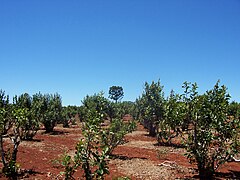
The plant is grown and processed mainly in South America, more specifically in Northern Argentina (Corrientes, Misiones), Paraguay, Uruguay and southern Brazil (Rio Grande do Sul, Santa Catarina and Paraná). The Guaraní are reputed to be the first people who cultivated the plant; the first Europeans to do this were Jesuit missionaries, who spread the drinking habit as far as Ecuador.
When the yerba is harvested, the branches are dried sometimes with a wood fire, imparting a smoky flavor. Then the leaves and sometimes the twigs are broken up.
There are many brands and types of yerba, with and without twigs, some with low powder content. Some types are less strong in flavor (suave, "mild") and there are blends flavored with mint, orange and grapefruit skin, etc.
The plant Ilex paraguariensis can vary in strength of the flavor, caffeine levels and other nutrients depending on whether it is a male or female plant. Female plants tend to be milder in flavor, and lower in caffeine. They are also relatively scarce in the areas where yerba maté is planted and cultivated, not wild-harvested, compared to the male plants.
Chemical composition and properties
Maté contains xanthines, which are alkaloids in the same family as caffeine, theophylline, and theobromine, well-known stimulants also found in coffee and chocolate. Maté also contains elements such as potassium, magnesium and manganese. Caffeine content varies between 0.3% and 1.7% of dry weight (compare this to 2.5–4.5% for tea leaves, and 1.5% for ground coffee).
Maté products are sometimes marketed as "caffeine-free" alternatives to coffee and tea, and said to have fewer negative effects. This is often based on a claim that the primary active xanthine in maté is "mateine", erroneously said to be a stereoisomer of caffeine. However, it is not chemically possible for caffeine to have a stereoisomer, and "mateine" is an official synonym of caffeine in the chemical databases.
From reports of personal experience with maté, its physiological effects are similar to (yet distinct from) more widespread caffeinated beverages like coffee, tea, or guarana drinks. Users report a mental state of wakefulness, focus and alertness reminiscent of most stimulants, but often remark on maté's unique lack of the negative effects typically created by other such compounds, such as anxiety, diarrhea, "jitteriness", and heart palpitations.
Reasons for maté's unique physiological attributes are beginning to emerge in scientific research. Studies of maté, though very limited, have shown preliminary evidence that the maté xanthine cocktail is different from other plants containing caffeine most significantly in its effects on muscle tissue, as opposed to those on the central nervous system, which are similar to those of other natural stimulants. Mate has been shown to have a relaxing effect on smooth muscle tissue, and a stimulating effect on myocardial (heart) tissue.
Mate's negative effects are anecdotally claimed to be of a lesser degree than those of coffee, though no explanation for this is offered or even credibly postulated, except for its potential as a placebo effect. Many users report that drinking yerba maté does not prevent them from being able to fall asleep, as is often the case with some more common stimulating beverages, while still enhancing their energy and ability to remain awake at will. However, the net amount of caffeine in one preparation of yerba maté is typically quite high, in large part because the repeated filling of the maté with hot water is able to extract the highly-soluble xanthines extremely effectively. It is for this reason that one maté may be shared among several people and yet produce the desired stimulating effect in all of them.
In vivo and in vitro studies are showing yerba maté to exhibit significant cancer-fighting activity. Researchers at the University of Illinois (2005) found yerba maté to be "rich in phenolic constituents" and to "inhibit oral cancer cell proliferation" while it promoted proliferation of oral cancer cell lines at certain concentrations.
On the other hand, a study by the International Agency for Research on Cancer showed a limited correlation between oral cancer and the drinking of hot maté (no data were collected on drinkers of cold maté). Given the influence of the temperature of water, as well as the lack of complete adjustment for age, alcohol consumption and smoking, the study concludes that maté is "not classifiable as to its carcinogenicity to humans".Yerba maté consumption has been associated with increased incidence of bladder, esophageal, oral, squamous cell of the head and neck, and lung cancer.
The pyrrolizidine alkaloids contained in maté tea are known to produce a rare condition of the liver, veno-occlusive disease, which produces liver failure due to progressive occlusion of the small venous channels in the liver. One fatal case has been reported in a young British woman who consumed very large quantities of maté tea from Paraguay.
An August 11, 2005, United States patent application (documents #20050176777, #20030185908, and #20020054926) cites yerba maté extract as a monoamine oxidase inhibitor; the maximal inhibition observed in vitro was 40–50%. MAOIs being antidepressants, there is speculation that this may contribute to the calming effect of yerba maté.[citation needed]
In addition, it has been noted by the U.S. Army Center for Health Promotion and Preventive Medicine that yerba maté can cause high blood pressure when used in conjunction with other MAO inhibitors (such as Nardil and Parnate).
Emerging research also shows that yerba maté preparations can alter the concentration of members of the ecto-nucleoside triphosphate diphosphohydrolase (E-NTPDase) family, resulting in an elevated level of extracellular ATP, ADP, and AMP. This was found with chronic ingestion (15 days) of an aqueous yerba extract, and might lead to a novel mechanism for manipulation of vascular regenerative factors, i.e., treating heart disease.
